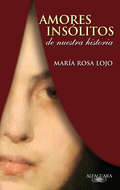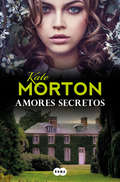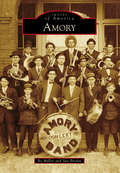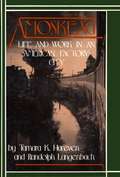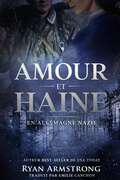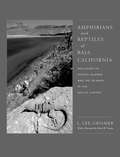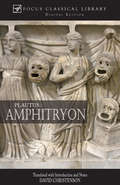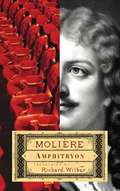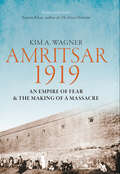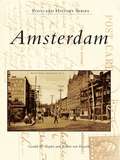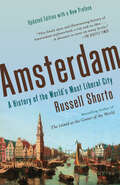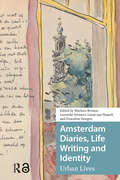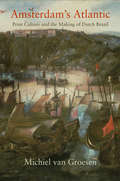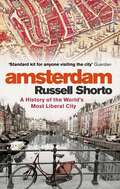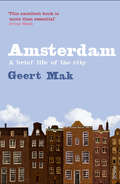- Table View
- List View
Amores insólitos de nuestra historia
by María Rosa LojoNueva edición ampliada con dos nuevos cuentos: La historia de Perón y Evita, y la del matrimonio de un Inglés y una hija de la Pampa. Si la experiencia del amor es, en principio, un patrimonio compartido por todos los seres humanos, en estos amores insólitos de nuestra historia se exacerban las distancias y las diferencias (de clase, raza, cultura, edad, poder), para bien y para mal de los amantes. Manuela Rosas, Domingo F. Sarmiento, Ulrich Schmidl, Julio A. Roca y Eduardo Wilde son algunos de los protagonistas de estas curiosas historias de amor, donde la investigación minuciosa y la documentación precisa se unen a la imaginación. Una anécdota poco visitada y la mejor literatura se dan cita, gracias a María Rosa Lojo, en estos amores insólitos que indagan la naturaleza de la pasión en una sociedad hecha de mezclas audaces y complejas alianzas.
Amores prohibidos
by Philippa Carr Alicia SteimbergSon idénticas, aunque solo en apariencias. Angelet es amable y dulce en su inocencia. Bersaba, enigmática y tortuosa en su sensualidad. Nunca se habían separado hasta que Bersaba enferma. Entretanto, Angelet se casa con Richard Tolworthy y se van a vivir a una taciturna mansión en Far Flamsted. Años más tarde y ya recuperada, Bersaba los visita, celosa de que su hermana haya conseguido un buen partido antes que ella. Angelet está a merced de los oscuros arcanos de la mansión que habita, mientras Bersaba está dispuesta a todo por conseguir el amor de un hombre. Nada la ha preparado para los secretos que desenmascarará en Far Flamstad. Angelet y Bersaba descubren que los mismos lazos que las unen pueden separarlas para siempre.
Amores secretos
by Kate Morton8 milhões de leitores já se renderam à escrita de Kate Morton. Amores Secretos é o mais recente romance da autora que fascina milhões de leitores em todo o mundo com as suas histórias de amor e mistério. «Sem dúvida, a autora do momento.» El Cultural Laurel, actriz de sucesso, regressa à casa da família para celebrar o nonagésimo aniversário da mãe, Dorothy, que sofre de Alzheimer. Esse dia recorda-lhe um outro, há muito esquecido. Naquele fatídico aniversário do seu irmão, Laurel estava escondida na casa da árvore, a fantasiar com um amor adolescente e um futuro grandioso em Londres, quando assistiu a um crime terrível, que mudaria a sua vida para sempre. Foi com terror que Laurel viu a mãe cravar a faca do bolo de aniversário no peito de um desconhecido. O regresso ao local onde tudo aconteceu é a última oportunidade para Laurel descobrir o temível segredo daquele dia e encontrar as respostas que só o passado da sua mãe lhe pode dar. Pista após pista, Laurel irá desvendar a história secreta de três desconhecidos que a Segunda Guerra Mundial uniu em Londres - Dorothy, Vivien e Jimmy - e cujos destinos ficaram para sempre ligados. Uma fascinante história de segredos e mistérios, de um crime obscuro e de um amor eterno. Mais um livro inesquecível de uma das autoras de maior sucesso dos nossos tempos. Sobre Amores secretos: «Protagonistas extraordinariamente complexos, paixão, mistério e um final surpreendente.» Booklist «Uma história evocadora sobre segredos em tempos de guerra e fidelidade familiar... A trama desenvolve-se com uma doçura fascinante, mas com uma pitada de inquietação.» Marie Claire«História, mistério e memória. Um romance em que passado e presente se entrelaçam com o mistério para cativar irremediavelmente o leitor.» ABC «Com uma sólida tradição de bestsellers, esta autora traz debaixo do braço mais uma história complexa e envolvente.» El Periodico
Amory (Images of America)
by Bo Miller Sue BrownIn November 1887, the Kansas City, Memphis & Birmingham Railroad (KCM&B)--later the St. Louis-San Francisco Railroad, or "Frisco"--established a new town as a halfway point on its route between Memphis and Birmingham. The town was named Amory in honor of Harcourt Amory, a prominent Bostonian and railroad executive. The 500 acres the railroad purchased from Amanda Owen were surveyed and drawn into plots parallel to the railroad tracks, creating Mississippi's first planned community. Amory prospered as men like E.D. Gilmore and Archibald Dalrymple moved to town and opened up shop. Businesses and homes from nearby Cotton Gin Port on the Tombigbee River were moved to Amory to be part of the growing town. The garment industry played a vital part in Amory's development, as the Glenn and Longenecker families established factories that made the town known as the "Pants Capital of the World." Today, the community is home to a regional medical center, top-rated schools, and a diverse mixture of retail and industrial businesses.
Amoskeag: Life and Work in an American Factory-City
by Tamara K. Hareven Randolph LangenbachFirst published in 1978, this classic book, through vivid oral histories and historic photographs, documents the social and cultural impact of the industry during America's rise as a manufacturing power. For nearly a century, the Amoskeag Manufacturing Company was chief architect of the social, ethnic, and economic existence of Manchester, New Hampshire. In the early 1900s, it was the largest textile mill in the world, employing 17,000; its red brick facade stretched for nearly a mile along the Merrimack River and its payroll drew immigrants by the thousands. In their own words, laborers, foremen, managers, and town residents paint a detailed portrait of the mill's nearly feudal dominance of every aspect of their lives and offer their response to this existence, with fierce pride and an unshakable sense of community. When competition, labor unrest, and obsolescence caught up with the mill in 1936, a weaver recalls, "the mills went out and the world stopped for everybody. "
Amour et Haine: En Allemagne nazie
by Ryan ArmstrongPendant la Seconde Guerre mondiale, un jeune garde nazi posté dans un ghetto de Ratisbonne en Allemagne se retrouve à une époque et dans un lieu qu’il déteste. Il n’a jamais directement pris part aux effusions de sang, mais n’a rien fait pour les empêcher. Il se demande si son âme a une chance d’être rachetée. Alors qu’on le somme de tuer une Juive, il lui sauve la vie, refusant d’obéir aux ordres en dépit des conséquences. La fille qu’il a secourue pourra-t-elle le sauver en retour ? Deviendra-t-elle la clé de sa rédemption et la lumière qui guidera son âme ?
Amphibians and Reptiles of Baja California, Including Its Pacific Islands and the Islands in the Sea of Cortés
by L. Lee GrismerThis is a comprehensive review of what is known about all of the species of amphibians and reptiles in Baja California.
Amphibious Assault Falklands: The Battle of San Carlos Water
by Ewen Southby-Tailyour Michael ClappA British Naval commander&’s eyewitness account of the 1982 war in the South Atlantic. Since he was in charge of the amphibious operations in the Falklands War, it goes without saying that there is no one better qualified to tell the story of that aspect of the campaign than Commodore Michael Clapp. Here he describes, with considerable candor, some of the problems met in a Navy racing to war and finding it necessary to recreate a largely abandoned operational technique in a somewhat ad hoc fashion. During the time it took to &“go south,&” some sense of order was imposed and a not very well defined command structure evolved, this was not done without generating a certain amount of friction. He tells of why San Carlos Water was chosen for the assault and the subsequent inshore operations. Michael Clapp and his small staff made their stand and can claim a major role in the defeat of the Argentine Air and Land Forces.
Amphibious Warfare: Battle on the Beaches (Casemate Short History)
by Oscar E. Gilbert Romain Cansiere&“An easily accessible short history&” of offensive military operations on hostile shores from the authors of First to Fight: The U.S. Marines in World War I (Midwest Book Review). One of the most difficult types of warfare to master, landing on a hostile beach requires scrupulous planning and intense coordination between the air, sea, and land forces. With a history reaching back to the Persians landing on the Greek shores at the Battle of Marathon in 490 BC, it was the First World War that marked the beginning of modern amphibious warfare, with the Royal Marines combining their efforts with the Royal Navy. Despite the disastrous Gallipoli amphibious operation to seize the Dardanelles Straits in 1915, the Royal Navy and US Marine Corps continued to develop new landing crafts through the interwar years. The Second World War proved more successful for amphibious warfare, with the Japanese invasion of the Philippines in 1941 crushing the American forces defending the Pacific islands and the D-Day landings by the Allied troops in 1944 initiating the beginning of the end of the war in Europe. This accessible short history looks at the historical development of amphibious warfare, telling the stories of particular landings and the units that have taken part in this unique type of warfare. The Royal Marines and US Marine Corps continue to evolve and play a crucial role in defense today, with specialized amphibious warfare ships being deployed to enable elite forces to respond promptly to threats across the globe. &“A brief but very useful overview of an important aspect of modern warfare.&” —Baird Maritime
Amphitryon
by David Christenson PlautusThe play Amphitryon provides an introduction to the world of Roman comedy from one of its best practitioners, Plautus. As with all Focus translations, the emphasis is on an inexpensive, readable edition that is close to the original, with an extensive introduction, notes and appendices.
Amphitryon
by Molière Richard Wilbur"Richard Wilbur's translations of classic French drama are among the undiscovered treasure of our recent literature."-The Hudson ReviewMolière's late, elegant comedy, based on Plautus' Roman version, alludes to the love affairs of the French king. This is the fourth and final volume of Theatre Communication Group's series (with cover designs by Chip Kidd), completing trade publication of these vital theatrical works. ncludes Richard Wilbur's translation notes.Richard Wilbur is a two-time winner of the Pulitzer Prize, and a former poet laureate of the United States. His verse translations of Molière's plays have been performed for audiences throughout the world.
Amplifications of Black Sound from Colonial Mexico: Vocality and Beyond (Critical Mexican Studies)
by Sarah FinleyThinkers like W. E. B. Du Bois and Paul Gilroy have long championed sound as an affective register of Black subjectivity, particularly in the African Atlantic. Prior studies in this vein focus on Anglophone or Caribbean contexts, a tendency that furthers Mexico&’s marginalization within narratives of the Black and African diaspora and mutes Afro-descendant traditions that date back to the sixteenth century. Indeed, the New Spanish archive contains whispers of the region&’s Black sound cultures, including monetary records for the voices of enslaved singers and representations of Black music in casta paintings. Despite such evidence, it is difficult to attend fully to these subaltern voices, for the cultural filters of the lettered elite often mute or misinterpret non-European sounds.Amplifications of Black Sound from Colonial Mexico is the first extensive study of Afro-descendant sonorities in New Spain or elsewhere in colonial Latin America. In this context, it attends to Black sounds through a framework that remixes Jacques Derrida&’s reading of the ear&’s anatomy with theories like Gilroy&’s lower frequencies or Fred Moten&’s phonic materiality. Sarah Finley&’s aim is to unsettle the divide between self and other so the auditory archive might emerge as a polyphonic record that exceeds dichotomies of sounding object / listening subject. Through sampling the Afro-descendant sounds of this archive, this book recovers and rearticulates Black voices and auditory practices in New Spain.
Amritsar 1919: An Empire of Fear & the Making of a Massacre
by Kim A. Wagner“Chronicles the run up to Jallianwala Bagh with spellbinding . . . focus. . . . Mr. Wagner’s achievement is one of balance . . . and, above, all, of perspective.” (The Wall Street Journal)The Amritsar Massacre of 1919 was a seminal moment in the history of the British Empire, yet it remains poorly understood. In this dramatic account, Kim A. Wagner details the perspectives of ordinary people and argues that General Dyer’s order to open fire at Jallianwalla Bagh was an act of fear. Situating the massacre within the “deep” context of British colonial mentality and the local dynamics of Indian nationalism, Wagner provides a genuinely nuanced approach to the bloody history of the British Empire.“Mr Wagner argues his case fluently and rigorously in this excellent book.” —The Economist“Written with a humane commitment to the truth that will impress.” —The Times“Skillfully maps a tale of growing tensions, precipitate action, and troubled aftermath.” —The Telegraph“A compelling account” —Financial Times“Wagner's postmortem of an imperial disaster should be widely read.” —R.A. Callahan, emeritus, Choice“The fullest, and by far the most authoritative, account of the causes and course of the Jallianwala massacre in any language.” —Nigel Collett, author of The Butcher of Amritsar“Mining a variety of sources – diaries, memoirs and court testimonies—[Wagner] uncovers fresh perspectives and examines the relation between colonial panic and state brutality with sophistication, sincerity and style.” —Santanu Das, author of India, Empire, and First World War Culture“Analytically sharp but gripping to read, the book is a page-turner”—Barbara D. Metcalf, co-author of A Concise History of India“An important book.” –Yasmin Khan, author of The Partition
Amsterdam
by Robert H. von Hasseln Gerald R. SnyderIn the 1700s, Amsterdam was just a small trading village in upstate New York. Utilizing its superior location astride critical waterways, the village grew during the westward expansion of the early 1800s to become an industrial powerhouse. By the 20th century, Amsterdam had become America's foremost rug-making center, nicknamed the "Carpet City," and the seventh largest city in New York. Waves of Dutch, German, Irish, Italian, and eastern European immigrants were drawn to the city for work. Some became mill workers while others became millionaires. The vintage postcards in Amsterdam tell the story of an American dream created, lost, and still pursued on what was once America's frontier.
Amsterdam
by Russell ShortoAn endlessly entertaining portrait of the city of Amsterdam and the ideas that make it unique, by the author of the acclaimed Island at the Center of the World Tourists know Amsterdam as a picturesque city of low-slung brick houses lining tidy canals; student travelers know it for its legal brothels and hash bars; art lovers know it for Rembrandt's glorious portraits. But the deeper history of Amsterdam, what makes it one of the most fascinating places on earth, is bound up in its unique geography-the constant battle of its citizens to keep the sea at bay and the democratic philosophy that this enduring struggle fostered. Amsterdam is the font of liberalism, in both its senses. Tolerance for free thinking and free love make it a place where, in the words of one of its mayors, "craziness is a value." But the city also fostered the deeper meaning of liberalism, one that profoundly influenced America: political and economic freedom. Amsterdam was home not only to religious dissidents and radical thinkers but to the world's first great global corporation. In this effortlessly erudite account, Russell Shorto traces the idiosyncratic evolution of Amsterdam, showing how such disparate elements as herring anatomy, naked Anabaptists parading through the streets, and an intimate gathering in a sixteenth-century wine-tasting room had a profound effect on Dutch-and world-history. Weaving in his own experiences of his adopted home, Shorto provides an ever-surprising, intellectually engaging story of Amsterdam from the building of its first canals in the 1300s, through its brutal struggle for independence, its golden age as a vast empire, to its complex present in which its cherished ideals of liberalism are under siege.
Amsterdam Anatomy Lessons Dissected
by Thomas Gulik Frank IJpmaThis book gives the historical perspective of 17th century Dutch paintings for ‘Anatomy lessons’ using pairning that were created for the Surgeons’ Guild in Amsterdam, to aid surgeons in teaching and knowledge. The iamges show the corpse and dissections are described and discussed.
Amsterdam Diaries, Life Writing and Identity: Urban Lives (Cities and Cultures)
by Marleen Rensen Leonieke Vermeer Laura Van Hasselt Ernestine HoegenThis volume invites readers to rediscover Amsterdam through the intimate lens of its inhabitants. Amsterdam Diaries, Life Writing and Identity offers a rich and layered portrayal of the city through the self-narratives of ‘ordinary’ individuals from the eighteenth century to the present. Exploring diaries, letters, oral histories and digital self-expressions, this volume reveals how people have experienced, navigated, and shaped their urban environment across time. It bridges life writing studies and urban history, shedding light on questions of identity, belonging, and the emotional bonds between individuals and the city. Special attention is given to marginalised voices, including migrant experiences, and to the evolving forms of self-representation in the digital age. Expanding the boundaries of life writing, the collection even incorporates non-human perspectives, such as dogs and bicycles. Together, these diverse narratives offer a kaleidoscopic view of life in Amsterdam, illustrating how the city is both a shared space and a deeply personal landscape.
Amsterdam Human Capital
by Sako Musterd Willem SaletThe familiar shape of western cities is changing dramatically. For long times the urban core was taken for granted as the focal point for international contacts and day-to-day activities in the region. Currently, the urban scope is transforming into multi centred forms at metropolitan scale. The transition is not just a matter of spatial form, it is reflecting social, economic and cultural processes. The question is what new identities may develop in such changing historical conditions of space and place.This book is a first attempt to analyse the process of urban transformation in an integral way. The focus is on the region of Amsterdam. All contributions are written by senior researchers of the Amsterdam studycentre for the Metropolitan Environment (AME). AME is the interdisciplinary urban research institute of the Universiteit van Amsterdam.As the urban research institute at the Universiteit van Amsterdam, the Amsterdam studycentre for the Metropolitan Environment (AME) analyses the economic, social and cultural aspects of this spatial transformation, usually in international comparative research. All contributions to this book are written by senior researchers of AME in an attempt to analyse in an integral way the present and future dilemmas out of the historical growth paths of this dynamic city.
Amsterdam's Atlantic: Print Culture and the Making of Dutch Brazil (The Early Modern Americas)
by Michiel van GroesenIn 1624 the Dutch West India Company established the colony of Brazil. Only thirty years later, the Dutch Republic handed over the colony to Portugal, never to return to the South Atlantic. Because Dutch Brazil was the first sustained Protestant colony in Iberian America, the events there became major news in early modern Europe and shaped a lively print culture.In Amsterdam's Atlantic, historian Michiel van Groesen shows how the rise and tumultuous fall of Dutch Brazil marked the emergence of a "public Atlantic" centered around Holland's capital city. Amsterdam served as Europe's main hub for news from the Atlantic world, and breaking reports out of Brazil generated great excitement in the city, which reverberated throughout the continent. Initially, the flow of information was successfully managed by the directors of the West India Company. However, when Portuguese sugar planters revolted against the Dutch regime, and tales of corruption among leading administrators in Brazil emerged, they lost their hold on the media landscape, and reports traveled more freely. Fueled by the powerful local print media, popular discussions about Brazil became so bitter that the Amsterdam authorities ultimately withdrew their support for the colony.The self-inflicted demise of Dutch Brazil has been regarded as an anomaly during an otherwise remarkably liberal period in Dutch history, and consequently generations of historians have neglected its significance. Amsterdam's Atlantic puts Dutch Brazil back on the front pages and argues that the way the Amsterdam media constructed Atlantic events was a key element in the transformation of public opinion in Europe.
Amsterdam's Sephardic Merchants and the Atlantic Sugar Trade in the Seventeenth Century
by Yda SchreuderThis book surveys the role of Amsterdam’s Sephardic merchants in the westward expansion of sugar production and trade in the seventeenth-century Atlantic. It offers an historical-geographic perspective, linking Amsterdam as an emerging staple market to a network of merchants of the “Portuguese Nation,” conducting trade from the Iberian Peninsula and Brazil. Examining the “Myth of the Dutch,” the “Sephardic Moment,” and the impact of the British Navigation Acts, Yda Schreuder focuses attention on Barbados and Jamaica and demonstrates how Amsterdam remained Europe’s primary sugar refining center through most of the seventeenth century and how Sephardic merchants played a significant role in sustaining the sugar trade.
Amsterdam: A History of the World's Most Liberal City
by Russell ShortoAmsterdam is not just any city. Despite its relative size it has stood alongside its larger cousins - Paris, London, Berlin - and has influenced the modern world to a degree that few other cities have. Sweeping across the city's colourful thousand year history, Amsterdam will bring the place to life: its sights and smells; its politics and people. Concentrating on two significant periods - the late 1500s to the mid 1600s and then from the Second World War to the present, Russell Shorto's masterful biography looks at Amsterdam's central preoccupations. Just as fin-de-siecle Vienna was the birthplace of psychoanalysis, seventeenth century Amsterdam was the wellspring of liberalism, and today it is still a city that takes individual freedom very seriously. A wonderfully evocative book that takes Amsterdam's dramatic past and present and populates it with a whole host of colourful characters, Amsterdam is the definitive book on this great city.
Amsterdam: A brief life of the city
by Geert MakA magnet for trade and travellers from all over the world, stylish, cosmopolitan Amsterdam is a city of dreams and nightmares, of grand civic architecture and legendary beauty, but also of civil wars, bloody religious purges, and the tragedy of Anne Frank. In this fascinating examination of the city's soul, part history, part travel guide, Geert Mak imaginatively recreates the lives of the early Amsterdammers, and traces Amsterdam's progress from waterlogged settlement to a major financial centre and thriving modern metropolis
Amsterdam’s Canal District: Origins, Evolution, and Future Prospects
by Jan NijmanIn terms of design, scale, and blending of ecologicical and aesthetic function, Amsterdam’s seventeenth-century Canal District is a European marvel. Its survival for four centuries is a testament to its ingenuity, reflected in its designation as a UNESCO World Heritage Site in 2010. The Canal District today is an extraordinary example of resilient historic design and cultural heritage in a living city, but it is not without present-day challenges: in recent years, its urban ecology has become subject to severe pressures of global tourism and supergentrification. This edited volume brings together seventeen reputable scholars to debate questions about the origins, evolution, and future of the Canal District. With these differing approaches and perspectives, on the Canal District, the contributions render a collection where the whole is much more than the sum of the parts. The book breaks new ground in our understanding of the District’s historic design, its evolution over four hundred years, and the fundamental issues in future-facing strategies and policies towards the future. While the main focus is clearly on Amsterdam, the discussions in this collection have an important bearing on broader questions of urban historic preservation elsewhere, and on questions about enduring urban design.
Amtrak in the Heartland (Railroads Past and Present)
by Craig Sanders"Craig Sanders has done an excellent job of research . . . his treatment is as comprehensive as anyone could reasonably wish for, and solidly based. In addition, he succeeds in making it all clear as well as any human can. He also manages to inject enough humor and human interest to keep the reader moving." —Herbert H. Harwood, author of The Lake Shore Electric Railway Story and Invisible Giants: The Empires of Cleveland's Van Sweringen BrothersA complete history of Amtrak operations in the heartland, this volume describes conditions that led to the passage of the Rail Passenger Service Act of 1970, the formation and implementation of Amtrak in 1970–71, and the major factors that have influenced Amtrak operations since its inception. More than 140 photographs and 3 maps bring to life the story as told by Sanders. This book will become indispensable to train enthusiasts through its examination of Americans' long-standing fascination with passenger trains. When it began in 1971, many expected Amtrak to last about three years before going out of existence for lack of business, but the public's continuing support of funding for Amtrak has enabled it and the passenger train to survive despite seemingly insurmountable odds.
Amtrak, America's Railroad: Transportation's Orphan and Its Struggle for Survival (Railroads Past and Present)
by Jeffrey T. Darbee Geoffrey H. Doughty Eugene E. HarmonDiscover the story of Amtrak, America's Railroad, 50 years in the making.In 1971, in an effort to rescue essential freight railroads, the US government founded Amtrak. In the post–World War II era, aviation and highway development had become the focus of government policy in America. As rail passenger services declined in number and in quality, they were simultaneously driving many railroads toward bankruptcy. Amtrak was intended to be the solution.In Amtrak, America's Railroad: Transportation's Orphan and Its Struggle for Survival, Geoffrey H. Doughty, Jeffrey T. Darbee, and Eugene E. Harmon explore the fascinating history of this popular institution and tell a tale of a company hindered by its flawed origin and uneven quality of leadership, subjected to political gamesmanship and favoritism, and mired in a perpetual philosophical debate about whether it is a business or a public service. Featuring interviews with former Amtrak presidents, the authors examine the current problems and issues facing Amtrak and their proposed solutions.Created in the absence of a comprehensive national transportation policy, Amtrak manages to survive despite inherent flaws due to the public's persistent loyalty. Amtrak, America's Railroad is essential reading for those who hope to see another fifty years of America's railroad passenger service, whether they be patrons, commuters, legislators, regulators, and anyone interested in railroads and transportation history.
